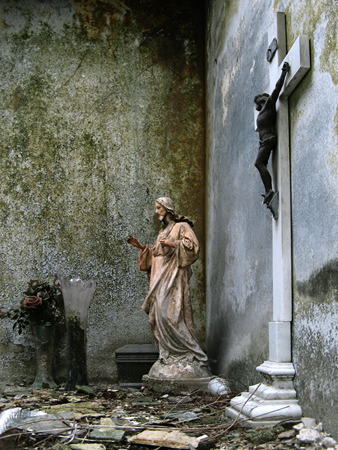
Documenting Recoleta Cemetery in Buenos Aires since 2007
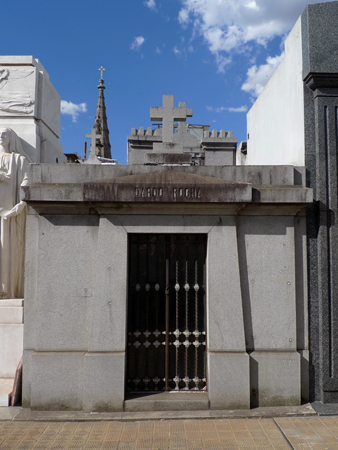
In Recoleta Cemetery, several tombs have been “vacated” by their former residents. Most, as with José de San Martín’s parents, have been returned to the place they were from. But that is not the case with Dardo Rocha, one of the most active politicians of the 19th century & founder of the city of La Plata.
Born in Buenos Aires in 1838, Rocha studied law & like almost all politicians of the era, first joined the military. He fought in the War of the Triple Alliance, where he was badly injured in the battle Curupaytí… the same skirmish where the adopted son of Domingo Faustino Sarmiento died. Rocha later occupied several government positions, but he is most remembered for his role in the foundation of the capital of Buenos Aires Province.
After the 1880 Revolution which officially separated the city of Buenos Aires from its province, Governor Rocha needed to create a new city to house provincial authorities. A commission began searching for different locations for the new city, prioritizing the terrain & easy connection to Buenos Aires. Dolores, Quilmes & Chascomús were options but in the end Ensenada was chosen for its proximity to the river & already having a rail line in service. The city would be built from scratch & Pedro Benoit, a personal friend of Rocha, was invited to design it.
With a big inauguration party, the foundation stone was placed on Novemeber 19, 1882… the birthday of Ponciano, youngest son of Dardo Rocha. The painting below, based on a photograph by Thomas Bradley, records the events of that day:
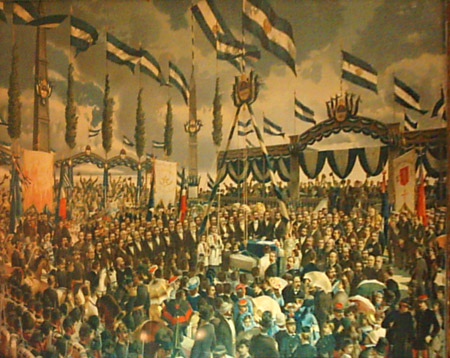
President Julio Argentino Roca was absent with no explanation & was instead represented by Minister Victorino de La Plaza. The distance between Rocha & the President became evident in 1886, when Roca decided to support instead his brother-in-law Miguel Juárez Celman as presidential candidate.
Retired from public life & a widower since 1917, Rocha passed away in his Buenos Aires residence in 1921. After the home wake, his remains were taken to Recoleta Cemetery two days after his death. The Province of Buenos Aires governor sent a telegraph to Rocha’s son, stating that Dardo Rocha should be laid to rest in La Plata. But the request was denied since Rocha’s will expressly stated that he be buried in the family vault in Recoleta alongside his wife.
In 1940 it was decided to transfer Rocha’s remains to the city he founded more than half a century earlier… even though it was not his final wish. A commission composed of influential people & city institutions received the caskets of Dardo Rocha & his wife with great ceremony. Below is the funeral coach parading through the city center:
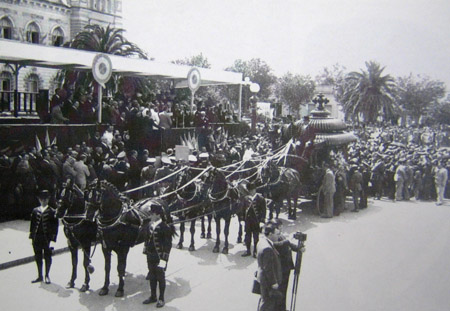
The caskets were later deposited in a crypt built beneath the La Plata cathedral:
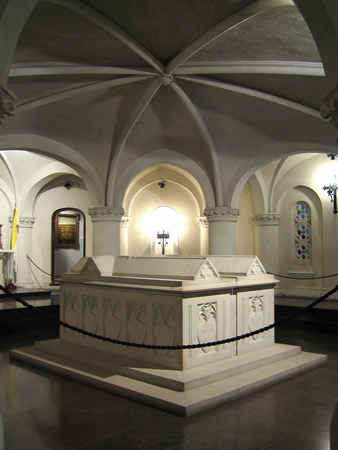
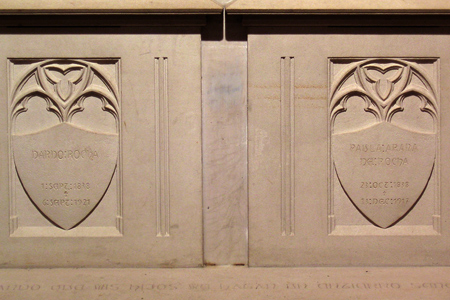
———————————————————
Update (08 Dec 2011): Marcos Arana Panissal, who claims to be a direct descendant of Dardo Rocha, filed a request yesterday with the Archdiocese of La Plata to remove his ancestor’s remains (& those of his wife) from the cathedral crypt to a more prominent location. Panissal also claims that Rocha was not a practicing Catholic, so the current burial spot is inappropriate. While city officials check genealogy, Monsignor Raúl Gross finds the request odd… especially because every November 19th (the day La Plata was founded), many of Rocha’s descendants participate in a commemorative mass held in his honor. Stay tuned & click here to read the entire article (in Spanish).
2 Comments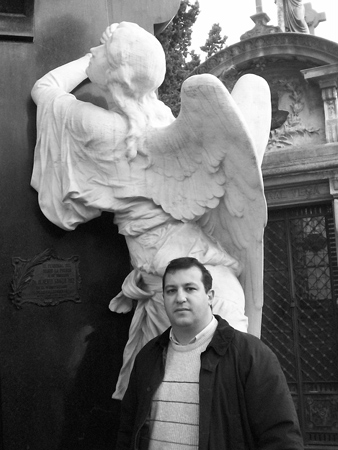
Interview with Diego Zigiotto
Guidebook for the city of the dead by Marcelo Metayer
The author of “1001 Curiosities of Recoleta Cemetery” assures that “there are a lot of people inside that no one knows about” & that he has more than enough material for a sequel.
Diego Zigiotto, a Buenos Aires journalist with a degree in tourism, is also a specialized guide in the city. In 2007 he published “1001 Curiosities of Buenos Aires” & his experience with the most famous burial site in Argentina led him to write his most recent work, “1001 Curiosities of Recoleta Cemetery.”
You’re a newspaper journalist & a tour guide. How do the two professions fit together?
By chance. I was already a reporter, I worked six years in radio, later I quit & began working in tourism. When I started to study tourism (*note: Argentina, like most countries in Europe, has a degree program for tourism), a professor told me: “Since you’re a reporter, you should be a tour guide.” It wasn’t a bad idea, so I began studying to be a guide. I created new routes, one of them being “Curiosities of Buenos Aires.” People told me, “Why don’t you give us something written? It’s a lot of info.” So I began writing. When I had a little over 200 pages, I presented it to a publisher (Cuatro Vientos), put up some cash, family & friends chipped in, & “1001 Curiosities of Buenos Aires” came out. Later the publishing house Norma called where it was re-edited & both careers came together.
How did you start with the book about the cemetery?
I’d always liked this cemetery & for the past two years I’ve worked as a voluntary guide. There were already two books about the cemetery, that of (Oscar) López Mato with good photos & information but with errors, & that of María Rosa Lojo that has some 10 or 12 historical short stories which can’t be used as factual. So I said, I’m going to do something different. There are a lot of people here that no one knows about, but the publisher told me “lighten up a bit because the book will be like a dictionary.”
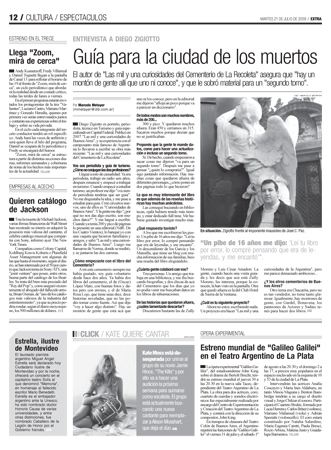
But there are still a lot of names, over 200…
A bit over 300. And several weren’t included. There were 450 & we cut it down to 315. We removed many because they said we couldn’t justify including them all.
You propose that people send you information to do an update or even a sequel to this book.
Yes. In fact, we began to take out information & they said, “it’s good for a second book.” Later I thought, who would buy it? I still gather info anyway. Lots of specifics were taken away from different entries… how do you put in two pages everything that these people did?
What’s very interesting about the book is that besides historical summaries, there are many anecdotes.
I found them by immersing myself in libraries. I would have liked to have had more time for that… for full-time research & further investigation.
What kind of response have you had?
Those who have written me liked the book. A 16-year old kid told me, “I read your book by mistake. I bought it thinking it was urban myths/stories, but I loved it.” A descendant of the García Mansilla family who has a blog with a lot of their personal history wrote a post praising the book.
How many people worked with you?
Three people. A friend who works in a library searched for biographies for me, & two women from the cemetery researched information in burial records when I couldn’t come myself.
Of the stories which were removed, which do you regret not including?
We argued a lot about those of Zully Moreno & Luis César Amadori. When people take a guided tour & you tell them Zully Moreno is here, they’re interested because they know her & they’ve seen her onscreen. Another that was deleted is the Club Hotel of Sierra de la Ventana.
What is your next project?
I’m not writing anything now. One project was to do “1001 Curiosities of Argentina,” but it seems a bit ambitious.
And the other cemeteries of Buenos Aires?
Another project was Chacarita, but it wouldn’t sell as well & it doesn’t have as much glamour. Still, there are tons of people (Gardel, Bonavena, the Actors & SADAIC pantheons) to fill two books.
————————————
Original article in Spanish not available online. The lead photograph was taken by Marcelo Metayer.
Zigiotto mentioned to Marcelo during the interview that he came across this blog several times while looking for information about Recoleta Cemetery, & he was surprised information about the cemetery was available in English. I checked his bibliography for a mention of AfterLife —it’s currently for sale at the cemetery gate for 58 pesos— but no credit is given. That’s too bad.
Update: A revised digital edition was made available in 2018.
10 Comments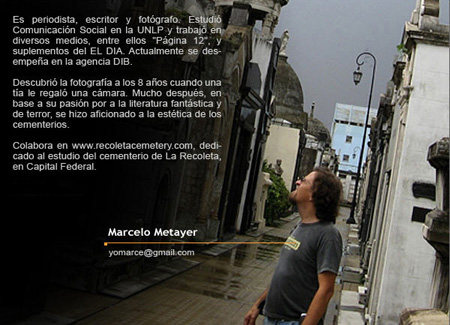
La Plata newspaper El Día recently published a compilation of Marcelo’s photos in their cultural supplement Cubo. The March 19th online gallery (unavailable as of 2020) consisted of several cemetery photos, some of which were taken in Recoleta Cemetery. He mentioned participating in this blog, but unfortunately no link was published.
———————————–
Update 26 Mar 09: A link to this blog was added as well as many other photos by Marcelo. We’re finally getting some real press!
Leave a Comment